Caryn
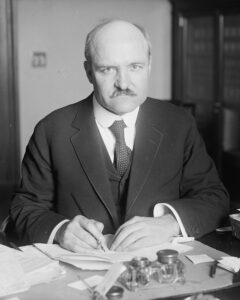 No matter what your opinion is on the use of Daylight Savings Time and Standard Time, the was originally a good reason for it, and that reason still applies today in many ways. The Standard Time Act of 1918, which was also known as the Calder Act (after the senator who sponsored the bill…William M. Calder), was the first United States federal law implementing Standard time and Daylight Saving Time in the United States. Prior to the Calder Act, the railroads had instituted time zones so that the rail schedule could have much needed consistency. Before time zones, no one had any idea when the train was due. It was a big mess. The Time Zone system defined five time zones for the United States and authorized the Interstate Commerce Commission to define the limits of each time zone.
No matter what your opinion is on the use of Daylight Savings Time and Standard Time, the was originally a good reason for it, and that reason still applies today in many ways. The Standard Time Act of 1918, which was also known as the Calder Act (after the senator who sponsored the bill…William M. Calder), was the first United States federal law implementing Standard time and Daylight Saving Time in the United States. Prior to the Calder Act, the railroads had instituted time zones so that the rail schedule could have much needed consistency. Before time zones, no one had any idea when the train was due. It was a big mess. The Time Zone system defined five time zones for the United States and authorized the Interstate Commerce Commission to define the limits of each time zone.
When the need for Daylight Savings Time came up, the original point of it was to save fuel by setting working hours so they coincided with the hours of natural daylight. While many people may not like that much, I think that a sensible person  can at least see the purpose of it. The act included a section that talked about the repeal of the change in one year, but in the end, it was decided that it was necessary to continue the practice. In fact, they could see no usefulness in repealing it, because the fuel savings had not changed. So, the practice has continued to this day. The Calder Act came about in answer to the European countries, who were already using the practice successfully.
can at least see the purpose of it. The act included a section that talked about the repeal of the change in one year, but in the end, it was decided that it was necessary to continue the practice. In fact, they could see no usefulness in repealing it, because the fuel savings had not changed. So, the practice has continued to this day. The Calder Act came about in answer to the European countries, who were already using the practice successfully.
Those who dislike the practice have been trying to repeal the act for as long as I can remember anyway, and with no success. I suppose that someday, they may succeed, but I’m not sure they will find that life without the time changes will be as amazing as they think. The sun will continue to make its  seasonal adjustments, and without the time changes, we will at some point, find ourselves wishing for another hour of daylight. The first time change to Daylight Saving Time took place on March 19, 1918, and it has been in practice since that time. I, personally, look forward to Daylight Saving Time every year. The longer days and more light make me feel happy, and I find that the few days or a week of adjustment is of little consequence in the grand scheme of things. Nevertheless, I’m sure I’ll hear lots of differing opinions from my readers. This year, Daylight Saving Time started on March 12, and Standard Time will begin on November 5…just so you know.
seasonal adjustments, and without the time changes, we will at some point, find ourselves wishing for another hour of daylight. The first time change to Daylight Saving Time took place on March 19, 1918, and it has been in practice since that time. I, personally, look forward to Daylight Saving Time every year. The longer days and more light make me feel happy, and I find that the few days or a week of adjustment is of little consequence in the grand scheme of things. Nevertheless, I’m sure I’ll hear lots of differing opinions from my readers. This year, Daylight Saving Time started on March 12, and Standard Time will begin on November 5…just so you know.
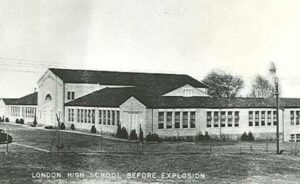 Years ago, when natural gas was first being used for energy, it had no odor, and so, if there was a leak, there was no warning. Natural gas was considered safe, and for the most part, it was, but when it leaked, and fumes pooled, any spark could be deadly. There is another kind of natural gas, called wet-gas that is less stable that natural gas, and probably should never have been used, but in the 1930s, the dangers were less known. Natural gas was more expensive, so sometimes consumers…mostly large consumers opted for the cheaper wet-gas to save a little money.
Years ago, when natural gas was first being used for energy, it had no odor, and so, if there was a leak, there was no warning. Natural gas was considered safe, and for the most part, it was, but when it leaked, and fumes pooled, any spark could be deadly. There is another kind of natural gas, called wet-gas that is less stable that natural gas, and probably should never have been used, but in the 1930s, the dangers were less known. Natural gas was more expensive, so sometimes consumers…mostly large consumers opted for the cheaper wet-gas to save a little money.
The Consolidated School of New London, Texas actually sat in the middle of a large oil and natural gas field. Texas is known for its oil and natural gas fields, and it wasn’t uncommon for towns to be build right in the middle of the fields. The area of New London was dominated by 10,000 oil derricks, 11 of which stood right on school grounds. The school, costing close to $1 million, was newly built in the 1930s and, from its inception, it bought natural gas from Union Gas to supply its energy needs. The school’s monthly natural gas bill averaged about $300 a month, and with such an exorbitant bill, the school officials were eventually persuaded to save money by switching over to the wet-gas lines, which were operated by Parade Oil Company. The lines ran near the school, and the cost to use them was definitely less. Wet-gas is a type of waste gas that has more impurities than typical natural gas and wasn’t as safe. Still, at the time, it wasn’t uncommon for consumers living near oil fields to use this gas.
On March 18, 1937, at approximately 3:05pm, a Thursday afternoon, school was about to end for the day, and  the 694 students and 40 teachers at the Consolidated School were waiting for the final bell, which was to ring in 10 minutes. It was not the final bell that was heard, but rather a huge explosion and powerful explosion shook the region. The blast literally blew the roof off of the building, leveled the school. There was no warning, because back then, natural gas was odorless. Nevertheless, in the presence of the leaking fumes, a single spark…or even static electricity, had the ability to create an explosion of indescribable proportions…and that is exactly what happened. When the blast came, it could be felt 40 miles away and most of the victims were killed instantly. From all over town, and even the surrounding towns, rescue workers and even everyday citizens rushed to the scene to pull out survivors. Surprisingly, hundreds of injured students were hauled from the rubble, and some students miraculously walked away unharmed. Ten students were found under a large bookcase that, when it fell, actually shielded them from the falling building. The rescue workers quickly established first-aid stations in the nearby towns of Tyler, Overton, Kilgore, and Henderson to tend to the wounded. It was noted that a blackboard at the destroyed school was found that read, “Oil and natural gas are East Texas’ greatest natural gifts. Without them, this school would not be here and none of us would be learning our lessons.” Yes, they were, but they could also be the greatest danger.
the 694 students and 40 teachers at the Consolidated School were waiting for the final bell, which was to ring in 10 minutes. It was not the final bell that was heard, but rather a huge explosion and powerful explosion shook the region. The blast literally blew the roof off of the building, leveled the school. There was no warning, because back then, natural gas was odorless. Nevertheless, in the presence of the leaking fumes, a single spark…or even static electricity, had the ability to create an explosion of indescribable proportions…and that is exactly what happened. When the blast came, it could be felt 40 miles away and most of the victims were killed instantly. From all over town, and even the surrounding towns, rescue workers and even everyday citizens rushed to the scene to pull out survivors. Surprisingly, hundreds of injured students were hauled from the rubble, and some students miraculously walked away unharmed. Ten students were found under a large bookcase that, when it fell, actually shielded them from the falling building. The rescue workers quickly established first-aid stations in the nearby towns of Tyler, Overton, Kilgore, and Henderson to tend to the wounded. It was noted that a blackboard at the destroyed school was found that read, “Oil and natural gas are East Texas’ greatest natural gifts. Without them, this school would not be here and none of us would be learning our lessons.” Yes, they were, but they could also be the greatest danger.
The investigators were never able to determine the exact cause of the spark that ignited the gas, noting that it very well may have been simple static electricity. Sadly, the dangers of wet-gas came more to light because of this incident, and as a result wet gas was required to be burned at the site rather than piped away. Also, as a safety precaution, a new state law was put into place, mandating the usage of malodorants in natural gas for  commercial and industrial use. This would provide a warning to anyone in the area of a natural gas leak, and hopefully prevent large casualties such as the ones felt in this explosion. The number of people estimated killed in the explosion is 294, but the actual number of victims remains unknown. The majority were from grades five through eleven, because the younger students were educated in a separate building, and most of them had already been dismissed from school. Many of the victims were only identified by their clothing or fingerprints, which was only available because many inhabitants of the surrounding area had been fingerprinted at the Texas Centennial Exposition the previous summer. Who could have known the importance of that exposition?
commercial and industrial use. This would provide a warning to anyone in the area of a natural gas leak, and hopefully prevent large casualties such as the ones felt in this explosion. The number of people estimated killed in the explosion is 294, but the actual number of victims remains unknown. The majority were from grades five through eleven, because the younger students were educated in a separate building, and most of them had already been dismissed from school. Many of the victims were only identified by their clothing or fingerprints, which was only available because many inhabitants of the surrounding area had been fingerprinted at the Texas Centennial Exposition the previous summer. Who could have known the importance of that exposition?
 Today is Saint Patrick’s Day, but I don’t believe in Luck. I believe in blessed. Saint Patrick’s Day celebrations are all about “the luck” of the Irish. I’m not real sure where that idea got started, and I know that it’s all in fun, but luck isn’t real, and blessing is. Saint Patrick was born in Britain, but he was kidnapped by Irish pirates at 16 and enslaved for six years. They took him to Ireland where he was enslaved and held captive for six years. Patrick writes in the Confession that “the time he spent in captivity was critical to his spiritual development.” Often it is when we are our lowest time, that we finally look up and find the Lord. He explains that “the Lord had mercy on his youth and ignorance and afforded him the opportunity to be forgiven his sins and convert to Christianity.” While Saint Patrick was held in captivity, he was assigned to work as a shepherd, but while there, he also strengthened his relationship with God through prayer, eventually leading him to convert to Christianity.
Today is Saint Patrick’s Day, but I don’t believe in Luck. I believe in blessed. Saint Patrick’s Day celebrations are all about “the luck” of the Irish. I’m not real sure where that idea got started, and I know that it’s all in fun, but luck isn’t real, and blessing is. Saint Patrick was born in Britain, but he was kidnapped by Irish pirates at 16 and enslaved for six years. They took him to Ireland where he was enslaved and held captive for six years. Patrick writes in the Confession that “the time he spent in captivity was critical to his spiritual development.” Often it is when we are our lowest time, that we finally look up and find the Lord. He explains that “the Lord had mercy on his youth and ignorance and afforded him the opportunity to be forgiven his sins and convert to Christianity.” While Saint Patrick was held in captivity, he was assigned to work as a shepherd, but while there, he also strengthened his relationship with God through prayer, eventually leading him to convert to Christianity.
After six years of captivity, Patrick heard a voice telling him in a dream that he would soon go home, and then that his ship was ready. There was no “luck” to it. God spoke to him in a dream, and he obeyed. He was blessed with his freedom. He immediately took action, and escaping from his master, he  travelled to a port, two hundred miles away. Once there, Patrick found a ship and with difficulty persuaded the captain to take him. After three days of sailing, they landed, presumably in Britain. Odd that they didn’t seem to know. All the passengers and crew left the ship, walking for 28 days in a “wilderness” and almost starving to death. After Patrick prayed for sustenance, they encountered a herd of wild boar, and since this was shortly after Patrick had urged them to put their faith in God, his reputation as a man of God grew. By the time Patrick arrived back to his family, he was a young man of twenty years. Patrick continued to study Christianity.
travelled to a port, two hundred miles away. Once there, Patrick found a ship and with difficulty persuaded the captain to take him. After three days of sailing, they landed, presumably in Britain. Odd that they didn’t seem to know. All the passengers and crew left the ship, walking for 28 days in a “wilderness” and almost starving to death. After Patrick prayed for sustenance, they encountered a herd of wild boar, and since this was shortly after Patrick had urged them to put their faith in God, his reputation as a man of God grew. By the time Patrick arrived back to his family, he was a young man of twenty years. Patrick continued to study Christianity.
After making his escape, Saint Patrick, who wasn’t a saint then, made his way back to Britain, but Ireland beckoned him, and he would eventually go back there. Patrick had a vision a few years after returning home, “I saw a man coming, as it were from Ireland. His name was Victoricus, and he carried many letters, and he gave  me one of them. I read the heading: ‘The Voice of the Irish,’ As I began the letter, I imagined in that moment that I heard the voice of those very people who were near the wood of Foclut, which is beside the western sea, and they cried out, as with one voice: ‘We appeal to you, holy servant boy, to come and walk among us.'” A.B.E. Hood suggests that the Victoricus of Saint Patrick’s vision may be identified with Saint Victricius, bishop of Rouen in the late fourth century, who had visited Britain in an official capacity in 396. However, Ludwig Bieler disagrees. I guess we will ever really know.
me one of them. I read the heading: ‘The Voice of the Irish,’ As I began the letter, I imagined in that moment that I heard the voice of those very people who were near the wood of Foclut, which is beside the western sea, and they cried out, as with one voice: ‘We appeal to you, holy servant boy, to come and walk among us.'” A.B.E. Hood suggests that the Victoricus of Saint Patrick’s vision may be identified with Saint Victricius, bishop of Rouen in the late fourth century, who had visited Britain in an official capacity in 396. However, Ludwig Bieler disagrees. I guess we will ever really know.
Acting on his vision, Patrick returned to Ireland as a Christian missionary, and that is how he became a patron saint of Ireland. Saint Patrick actually never used a four-leaf clover, but rather he used a three-leaf clover as a way to help people to understand the Trinity (Triune God – Father, Son, and Holy Spirit).

 Since buying their family farm, my nephew, Eric Parmely and his wife, Ashley have had a number of daily duties that are different from people who dwell in the cities and towns. Of course, there are the normal duties that go with a farm…everything from feeding animals, helping with births, gathering eggs, taking care of the land, and repairing fences. This year has been a little unusual in that like many areas across the United States, Wyoming has received an extra-large amount of snow, meaning that the rural roads, which are not always plowed by the county or state, are left buried in 3 to 6 feet of snow. That means that nothing is moving, and those people who happen to have tractors, will likely have to go out and help with the “digging out” process. That was the position Eric and Ashley found themselves in. One storm found them waiting for 3 days to get out, and then it only happened because Eric got out and became a snowplow. Of course, the whole thing didn’t totally hurt Eric’s feelings,
Since buying their family farm, my nephew, Eric Parmely and his wife, Ashley have had a number of daily duties that are different from people who dwell in the cities and towns. Of course, there are the normal duties that go with a farm…everything from feeding animals, helping with births, gathering eggs, taking care of the land, and repairing fences. This year has been a little unusual in that like many areas across the United States, Wyoming has received an extra-large amount of snow, meaning that the rural roads, which are not always plowed by the county or state, are left buried in 3 to 6 feet of snow. That means that nothing is moving, and those people who happen to have tractors, will likely have to go out and help with the “digging out” process. That was the position Eric and Ashley found themselves in. One storm found them waiting for 3 days to get out, and then it only happened because Eric got out and became a snowplow. Of course, the whole thing didn’t totally hurt Eric’s feelings, 
 because he loves his tractor, and this was a new way to use it. Men and their toys…right? The main thing is that they were finally able to get out and get back to the business of life.
because he loves his tractor, and this was a new way to use it. Men and their toys…right? The main thing is that they were finally able to get out and get back to the business of life.
Eric is a mechanic by trade and loves his work. That means that tinkering with anything mechanical is not really work. Getting on the farm equipment is that way exactly. When they bought the tractor, there were many evenings spent in the barn with his father-in-law, Albert Eighmy, son Bowen Parmely, and often Ashley and their daughters, Reagan, Hattie, and Maeve all watching as the work was done to this fantastic piece of equipment, so that it would be ready to be a regular piece of the menagerie of farm equipment necessary to run a farm. Bowen especially loves the tractor, because, being a boy, it seems to run in his blood. He is his daddy’s boy. The girls like to ride on it too, but they aren’t as interested in the mechanical side of things as Bowen is.
Eric has become a wonderful family man…a great husband and daddy. He and Ashley are doing the things 
 necessary to raise responsible, decent, and well-rounded kids. Their kids are homeschooled, which is becoming more and more necessary these days, given the radical activities in the school system now. And the kids are happier too. Ashley teaches school, and Eric brings home the bacon…back to old fashioned values. Not every family is run this way, but it works very well for them. Today is Eric’s birthday. Happy birthday Eric!! Have a great day!! We love you!!
necessary to raise responsible, decent, and well-rounded kids. Their kids are homeschooled, which is becoming more and more necessary these days, given the radical activities in the school system now. And the kids are happier too. Ashley teaches school, and Eric brings home the bacon…back to old fashioned values. Not every family is run this way, but it works very well for them. Today is Eric’s birthday. Happy birthday Eric!! Have a great day!! We love you!!

 One thing I never knew about my niece, Kellie Hadlock, is that she is the Hadlock Family Fashion Source. Of course, I know that Kellie is very fashionable, but I didn’t know that she was a “go-to” fashionista for them. When her sister, Lindsay Moore comes for visits from Laramie or Kellie goes there for visits, the girls often find themselves in the bedroom in front of the mirror, going through the clothes and putting things together to decide what looks best to wear. Lindsay told me that when she goes through pictures from their conversations, she finds that they are mostly of herself in different outfits. She wants to remember just how to wear things and what goes together, do she can look as fashionable as Kellie always does.
One thing I never knew about my niece, Kellie Hadlock, is that she is the Hadlock Family Fashion Source. Of course, I know that Kellie is very fashionable, but I didn’t know that she was a “go-to” fashionista for them. When her sister, Lindsay Moore comes for visits from Laramie or Kellie goes there for visits, the girls often find themselves in the bedroom in front of the mirror, going through the clothes and putting things together to decide what looks best to wear. Lindsay told me that when she goes through pictures from their conversations, she finds that they are mostly of herself in different outfits. She wants to remember just how to wear things and what goes together, do she can look as fashionable as Kellie always does.
Lindsay tells me that Kellie is her “go-to” source for fashion advice. I see Kellie every week at church, where she is one of the worship leaders. I know that she is very fashionable, but I wasn’t aware that her family counts on her fashion sense to make sure they look pretty and up to date. Still, I can’t say that I’m surprised, since I have found myself following Kellie’s fashion leads too. Lindsay was going through pictures and could that most of the pictures from their conversations were of herself in the styles that Kellie suggested. She wanted to make sure that she remembered the looks, so they could be repeated later. Lindsay says, “I can always count on her to tell it to me straight and that I will look cute by asking her!! She is truly the most fashionable in our family.”
Kellie continues to grow spiritually, and Lindsay has really loved their talks about God. They have started a new 
 study, whereby they try to read a chapter of the Bible each week and then they have text discussions about it. The Bible is so much more than the words on paper. There are much deeper meetings, when people take the time to search them out. Lindsay says that these have been rich discussions in which they have both learned so much. The Holy Spirit reveals different things to each of them, which is of course, awesome!! Lindsay says, “She is a wonderful sister, daughter, dog mom, aunt, and girlfriend. She is a cut above, a true gem.” I totally agree.
study, whereby they try to read a chapter of the Bible each week and then they have text discussions about it. The Bible is so much more than the words on paper. There are much deeper meetings, when people take the time to search them out. Lindsay says that these have been rich discussions in which they have both learned so much. The Holy Spirit reveals different things to each of them, which is of course, awesome!! Lindsay says, “She is a wonderful sister, daughter, dog mom, aunt, and girlfriend. She is a cut above, a true gem.” I totally agree.
Because the Hadlock family is spread out over Wyoming now, they have decided to meet in Wheatland this year for Kellie’s birthday lunch. Kellie really misses her sisters, Jessi and Lindsay, so her dad, Chris Hadlock suggested that we all meet in Wheatland which is the same amount of time away for each family. They plan to go this Saturday and have lunch at Guadalajara and have her little party for our family there. Kellie is so excited. Her whole family will be there, including her brother Ryan and his family. Then, the family here in Casper will have another birthday dinner for her on Sunday night. Kellie has chosen her favorite fried chicken, mashed potatoes and gravy, and corn. In the Hadlock family everyone gets to choose a birthday meal, or they can choose to go out to whatever restaurant. This year will be special for Kellie because the other girls could 
 not come up for her birthday. So she basically gets two parties…well, actually three, because her boyfriend, Tim Thompson is in town from Gillette to take her out for dinner today. Kellie gets to feel really special this year, with all this attention, and I think she has earned it, because she is a very special girl. Today is Kellie’s birthday. Happy birthday Kellie!! Have a great day!! We love you!!
not come up for her birthday. So she basically gets two parties…well, actually three, because her boyfriend, Tim Thompson is in town from Gillette to take her out for dinner today. Kellie gets to feel really special this year, with all this attention, and I think she has earned it, because she is a very special girl. Today is Kellie’s birthday. Happy birthday Kellie!! Have a great day!! We love you!!
 Every day, in various locations, we could find ourselves in relatively close proximity to any number of known criminals. I suppose that if one were to let oneself, that could be a source of concern, but it is also good to know that often, the criminal element in our midst is trying just as hard not to be seen, as we are not to know they are there.
Every day, in various locations, we could find ourselves in relatively close proximity to any number of known criminals. I suppose that if one were to let oneself, that could be a source of concern, but it is also good to know that often, the criminal element in our midst is trying just as hard not to be seen, as we are not to know they are there.
Many of those criminals are not seriously dangerous, but some are so dangerous that it was decided that the public needed to not only be aware of them, but needed to help in spotting this dangerous element, so they could be taken off our streets. The Federal Bureau of Investigation (FBI) made the decision in 1949 to institute what is now well known as the “Ten Most Wanted Fugitives” list in an effort to publicize particularly dangerous fugitives. The creation of the program arose out of a wire service news story in 1949 about the “toughest guys” the FBI wanted to capture. Once out there, like many new ideas, awareness grew, and a need was realized. The wire service story drew so much public attention that the “Ten Most Wanted” list was given the okay by J Edgar Hoover the following year.
Since its debut, the list has been responsible for the capture of hundreds of the criminals included on the list. To add to the success, more than 150 of those apprehended or located were a direct result of tips from the public. To start the list and in subsequent lists, the Criminal Investigative Division (CID) of the FBI asks all fifty-six field offices to submit candidates for inclusion on the list. Once these are received, the CID in association with the Office of Public and Congressional Affairs reviews then and proposes finalists for approval of by the FBI’s Deputy Director. The criterion for selection is simple. The criminal must have a lengthy record and current pending charges that make him or her particularly dangerous. In addition, the FBI must believe that “the publicity attendant to placement on the list will assist in the apprehension of the fugitive.”

Once on the list, there is generally only two ways to get off the list…die or to be captured. There have only been a handful of cases where a fugitive has been removed from the list because they no longer were a particularly dangerous menace to society. I suppose an older fugitive, known to have an illness or dementia would qualify. The list usually consists of men, but there have actually been ten women who have appeared on the Ten Most Wanted list. The first woman was Ruth Eisemann-Schier was the first, listed in 1968. The current list has a little room, I see.
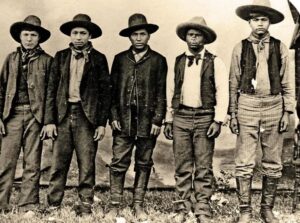 The Rufus Buck Gang was a multiracial group of African American and Native American outlaws, notorious for a series of murders, robberies, and assaults. They were a brutal bunch, and they considered anyone fair game…men, women, and children. Headed up by Rufus Buck, the gang also consisted of Lucky Davis, Maoma July, Lewis Davis, and Sam Sampson. The men had no scruples and no respect for life. Their criminal activities took place in the Indian Territory of the Arkansas-Oklahoma area from July 30, 1895, through August 4, 1896.
The Rufus Buck Gang was a multiracial group of African American and Native American outlaws, notorious for a series of murders, robberies, and assaults. They were a brutal bunch, and they considered anyone fair game…men, women, and children. Headed up by Rufus Buck, the gang also consisted of Lucky Davis, Maoma July, Lewis Davis, and Sam Sampson. The men had no scruples and no respect for life. Their criminal activities took place in the Indian Territory of the Arkansas-Oklahoma area from July 30, 1895, through August 4, 1896.
Before they started their crime spree, the gang began while staying in Okmulgee, Oklahoma, by building up a small stockpile of weapons. Then, on 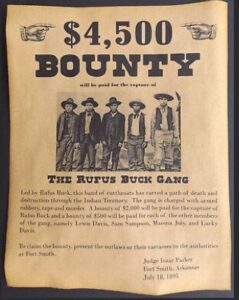 July 30, 1895, they killed Deputy US Marshal John Garrett. With the lawman out of the way, they began holding up various stores and ranches in the Fort Smith area over the next two weeks. Then, the brutality began. During one robbery, a salesman named Callahan, after being robbed, was offered a chance to escape…if he could outrun the gang. Callahan was an elderly man, and they thought an easy mark, but he successfully escaped, which angered the men, so the gang killed his assistant in frustration. At least two female victims who were raped by the gang died of their injuries.
July 30, 1895, they killed Deputy US Marshal John Garrett. With the lawman out of the way, they began holding up various stores and ranches in the Fort Smith area over the next two weeks. Then, the brutality began. During one robbery, a salesman named Callahan, after being robbed, was offered a chance to escape…if he could outrun the gang. Callahan was an elderly man, and they thought an easy mark, but he successfully escaped, which angered the men, so the gang killed his assistant in frustration. At least two female victims who were raped by the gang died of their injuries.
In all, the gang, Killed Deputy US Marshal John Garrett. Then on July 31, 1895, they came across a white man and his daughter in a wagon, the gang held the man at gunpoint and took the girl. They killed a black boy and beat Ben Callahan until they mistakenly believed he was dead, then took Callahan’s boots, money, and saddle. They robbed the country stores of West and J Norrberg at Orket, Oklahoma. They murdered two white women and a 14-year-old girl. Then, on August 4th, they raped a Mrs Hassen near Sapulpa, Oklahoma. Hassen and two of three other female victims of the gang…a Miss Ayres and an Indian girl 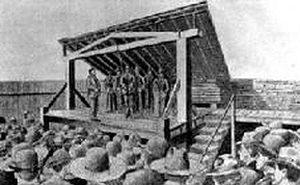 near Sapulpa, all died; and a fourth victim, Mrs Wilson recovered from her injuries. Continuing attacks on both local settlers and Creek indiscriminately, the gang was finally captured outside Muskogee by a combined force of lawmen and Indian police of the Creek Light Horse, led by Marshal S Morton Rutherford, on August 10. While the Creek Light Horse forces wanted to hold the gang for trial, the men were brought before “Hanging” Judge Isaac Parker. The judge twice sentenced them to death, the first sentence not being carried out pending an ultimately unsuccessful appeal to the Supreme Court. They were hanged on July 1, 1896 at 1pm at Fort Smith.
near Sapulpa, all died; and a fourth victim, Mrs Wilson recovered from her injuries. Continuing attacks on both local settlers and Creek indiscriminately, the gang was finally captured outside Muskogee by a combined force of lawmen and Indian police of the Creek Light Horse, led by Marshal S Morton Rutherford, on August 10. While the Creek Light Horse forces wanted to hold the gang for trial, the men were brought before “Hanging” Judge Isaac Parker. The judge twice sentenced them to death, the first sentence not being carried out pending an ultimately unsuccessful appeal to the Supreme Court. They were hanged on July 1, 1896 at 1pm at Fort Smith.
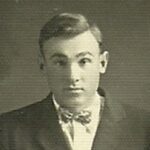
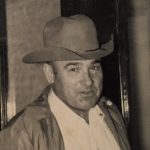 My husband’s grandfather, Andrew Carl Schulenberg was an interesting character. Born on March 12, 1906, to Max Heinrich Johann Carl Schulenberg and Julia Marie Doll. His dad was born in Oldenburg, Lower Saxony, Germany, and in those days, children were often given multiple middle names. I have always found that to be of interest, as I used to think that pretty much only royal children were given multiple middle names. It actually isn’t all that uncommon and many children today have multiple middle names. Max had immigrated to America by the time he met Julia, and they were married in Blair, Nebraska. Their oldest son, Andrew was born in Herman, Nebraska, as were his sisters Anna and Claudine. The rest of Andrew’s nine siblings were born in Forsyth, Montana.
My husband’s grandfather, Andrew Carl Schulenberg was an interesting character. Born on March 12, 1906, to Max Heinrich Johann Carl Schulenberg and Julia Marie Doll. His dad was born in Oldenburg, Lower Saxony, Germany, and in those days, children were often given multiple middle names. I have always found that to be of interest, as I used to think that pretty much only royal children were given multiple middle names. It actually isn’t all that uncommon and many children today have multiple middle names. Max had immigrated to America by the time he met Julia, and they were married in Blair, Nebraska. Their oldest son, Andrew was born in Herman, Nebraska, as were his sisters Anna and Claudine. The rest of Andrew’s nine siblings were born in Forsyth, Montana.
After a hunting accident took his right leg, Andy had a true peg leg for the rest of his life. Maybe it was the fact that he was only in his teens when it happened, or maybe it was just his own determined personality, but Andy did not let a “little thing” like an amputated leg turn him into an invalid. He went forward with his life…after about a year in the hospital, that is. And while he really didn’t like guns much after that, he was still capable of using one if needed. And actually, went on to become the sheriff of Rosebud County, Montana, and did it without a gun. I suppose it might have seemed a little bit like Sheriff Andy Taylor on the Andy Griffith Show, but I can’t say that Forsyth, or Rosebud County, was a tame as Mayberry was. Andy took it all in stride, worked with multiple agencies over his years as sheriff, and handled the Indian nation with mutual respect and grace. That was the reason they worked so well with him.
I first met Andy at a family reunion when my girls were about 6 and 5 years old. He was, of course their great 
 grandfather. And he seemed bigger than life. He was a tall…very tall man, but then I’m short, and maybe not a good judge of height. Still, I would guess 6 foot 3 inches, at last. His son, Uncle Butch Schulenberg could probably tell me for sure. Nevertheless, as big as he was, he took the time to build two small chairs for my girls, chairs they still love to this day. He was excited to meet them, and they were excited to meet him. I will always be glad we had that time with him. Today is the 117th anniversary of Grandpa Andy Schulenberg’s birth. Happy birthday in Heaven, Grandpa. We love and miss you very much.
grandfather. And he seemed bigger than life. He was a tall…very tall man, but then I’m short, and maybe not a good judge of height. Still, I would guess 6 foot 3 inches, at last. His son, Uncle Butch Schulenberg could probably tell me for sure. Nevertheless, as big as he was, he took the time to build two small chairs for my girls, chairs they still love to this day. He was excited to meet them, and they were excited to meet him. I will always be glad we had that time with him. Today is the 117th anniversary of Grandpa Andy Schulenberg’s birth. Happy birthday in Heaven, Grandpa. We love and miss you very much.
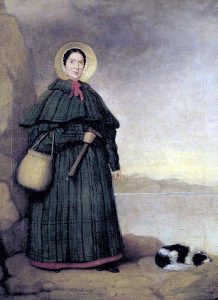 Few kids know what they want to do with their lives by the time they are ten or twelve, but twelve-year-old British fossil collector and paleontologist Mary Anning already knew. She was the child of a poor family, and she made her first archeological discovery the year she turned twelve. Anning searched for fossils in the area’s Blue Lias cliffs, particularly during the winter months when landslides exposed new fossils that had to be collected quickly before they were lost to the sea. One day, while fossil-hunting on the cliffs of Lyme Regis, England, Anning found what was believed to be the first dinosaur skeleton…an ichthyosaur, a prehistoric reptile.
Few kids know what they want to do with their lives by the time they are ten or twelve, but twelve-year-old British fossil collector and paleontologist Mary Anning already knew. She was the child of a poor family, and she made her first archeological discovery the year she turned twelve. Anning searched for fossils in the area’s Blue Lias cliffs, particularly during the winter months when landslides exposed new fossils that had to be collected quickly before they were lost to the sea. One day, while fossil-hunting on the cliffs of Lyme Regis, England, Anning found what was believed to be the first dinosaur skeleton…an ichthyosaur, a prehistoric reptile.
Prior to Anning’s discovery, people didn’t believe that anima extinction was a real thing. Anning was up against some big obstacles in the field of science, because of her gender, so it was amazing that her findings were given any credence at all. In addition, her social class…a big thing in those days, also made it difficult for her to fully participate in the scientific community of 19th-century Britain. Nevertheless, she read as much scientific literature as she could get her hands on and went on to become a renowned fossil-hunter and dealer, often risking her life in the face of landslides and daunting cliffs. She was not going to let her gender or social class stop her from using her mind to its fullest capacity. She wanted to learn more and discover more, and she was determined to do so. Anning did get some of the recognition she deserved when the great Stephen Jay Gould, who was the most beloved popular science writer of all time, called her “probably the most important unsung (or inadequately sung) collecting force in the history of paleontology.” To say the least, her work started a fundamental shift in scientific thinking about prehistoric life in the early 19th century.
Mary Anning was born on May 21, 1799. She struggled financially for much of her life. Her family was poor. Her father, a cabinetmaker, died when she was eleven. Anning, herself, nearly died in 1833 during a landslide that killed her dog, Tray. Working in landslide conditions was dangerous, but it was often her only chance to make her discoveries. Nevertheless, this English fossil collector, dealer, and paleontologist, went on to become known around the world for important finds she made in Jurassic marine fossil beds in the cliffs along the English Channel. In addition to the ichthyosaur, she found the first two more complete plesiosaur skeletons, the first pterosaur skeleton located outside Germany, and important fish fossils. Her observations also played a key role in the discovery that “coprolites, known as bezoar stones at the time, were fossilized feces. She also discovered that belemnite fossils contained fossilized ink sacs like those of modern cephalopods.” When geologist Henry De la Beche painted Duria Antiquior, the first widely circulated pictorial representation of a scene from prehistoric life derived from fossil reconstructions, he based it largely on fossils Anning had found, and sold prints of it for her benefit. A wonderful act of kindness.
Anning was not able to fully participate in the scientific community of 19th-century Britain, who were mostly Anglican gentlemen. Nevertheless, she became well known in geological circles in Britain, Europe, and America, and was consulted on issues of anatomy, as well as about collecting fossils. Still, as a woman, she was not eligible to join the Geological Society of London and she did not always receive full credit for her scientific  contributions…and incredible injustice. As a result, she wrote in a letter, “The world has used me so unkindly, I fear it has made me suspicious of everyone.” There was only one scientific writing of hers that was published in her lifetime. It appeared in the Magazine of Natural History in 1839. It was simply an extract from a letter that Anning had written to the magazine’s editor questioning one of its claims. It seems surprising to me that they printed that at all.
contributions…and incredible injustice. As a result, she wrote in a letter, “The world has used me so unkindly, I fear it has made me suspicious of everyone.” There was only one scientific writing of hers that was published in her lifetime. It appeared in the Magazine of Natural History in 1839. It was simply an extract from a letter that Anning had written to the magazine’s editor questioning one of its claims. It seems surprising to me that they printed that at all.
After her death on March 9, 1847, her unusual life story finally began to gain the interest it deserved. An uncredited author in All the Year Round, edited by Charles Dickens, wrote of her in 1865 that “[t]he carpenter’s daughter has won a name for herself, and has deserved to win it.” It has often been claimed that her story was the inspiration for the 1908 tongue-twister “She sells seashells on the seashore” by Terry Sullivan, but that has not been confirmed. In 2010, a full 163 years after her death, the Royal Society finally included Anning in a list of the ten British women who have most influenced the history of science. Rather late in all reality.
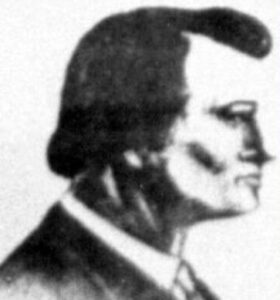 Joseph Alfred “Jack” Slade was a stagecoach and Pony Express superintendent early in his life. He was instrumental in the opening of the American West, and he was also the archetype of the Western gunslinger. Slade was born on January 22, 1831, in Carlyle, Illinois, the son of Illinois politician Charles Slade and Mary Dark (Kain) Slade. Slade’s life started out decent. He served in the US Army that occupied Santa Fe, 1847-1848, during the Mexican War. His father died in 1834, Slade’s mother married Civil War General Elias Dennis in 1838, when Slade was just seven years old.
Joseph Alfred “Jack” Slade was a stagecoach and Pony Express superintendent early in his life. He was instrumental in the opening of the American West, and he was also the archetype of the Western gunslinger. Slade was born on January 22, 1831, in Carlyle, Illinois, the son of Illinois politician Charles Slade and Mary Dark (Kain) Slade. Slade’s life started out decent. He served in the US Army that occupied Santa Fe, 1847-1848, during the Mexican War. His father died in 1834, Slade’s mother married Civil War General Elias Dennis in 1838, when Slade was just seven years old.
In about 1857, Slade married a woman named Maria Virginia. Her maiden name is unknown. In the 1850s, he was a freighting teamster and wagon master along the Overland Trail, and then became a stagecoach driver in Texas, around 1857-1858. After years on the job, Slade became a stagecoach division superintendent along the Central Overland route for Hockaday and Company from 1858–1859, and when it was purchased, he worked for its successors Jones, Russell and Company in 1859 and Central Overland, California and Pike’s Peak Express Company from 1859 to 1862. With the latter concern, he also helped launch and operate the Pony Express in 1860-61. These were critical lines of communication between the East and California. As superintendent, he enforced order and assured reliable cross-continental mail service, maintaining contact between Washington DC, and California on the eve of Civil War.
Slade was know as a strict, and even ferocious boss. While division superintendent, he shot and killed Andrew Ferrin, one of his subordinates, who was hindering the progress of a freight train, in May 1859. This type of situation was rare for the time, but it served to build his reputation as a gunslinger. In March 1860, Slade was ambushed and left for dead by Jules Beni, who was a corrupt stationkeeper at Julesburg, Colorado, and whom Slade had removed. Remarkably, Slade survived, and in August 1861, Beni was killed by Slade’s men after 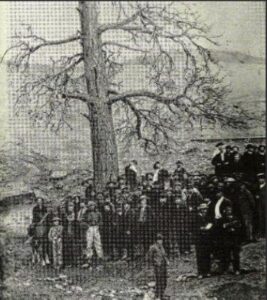 ignoring Slade’s warning to stay out of his territory.
ignoring Slade’s warning to stay out of his territory.
Slade’s temper and the reputation that came with it, combined with a drinking problem, caused his downfall. After he was fired by the Central Overland for drunkenness in November 1862, Slade crossed paths with the Virginia City Vigilance Committee, which was composed of honest, determined citizens, including bankers, storekeepers, miners, stockbrokers, and other citizens of all backgrounds, who had decided to take the law into their own hands and combat lawlessness in Virginia City. Slade found himself in Virginia City, Montana on a drunken spree. After being arrested, he was lynched by local vigilantes on March 10, 1864, for disturbing the peace. Of all the killings he was guilty of, Slade was lynched for disturbing the peace. Unbelievable, but the truth, nevertheless. He was buried in Salt Lake City, Utah, on July 20, 1864.

